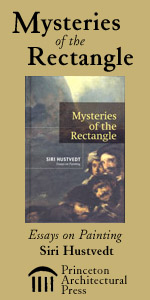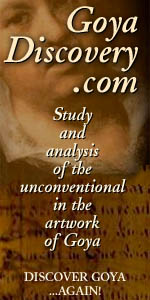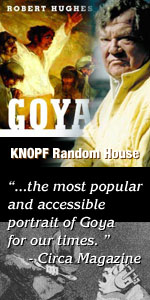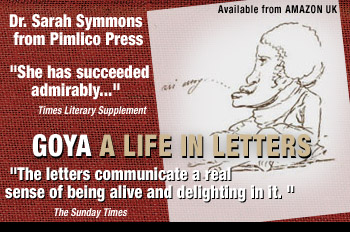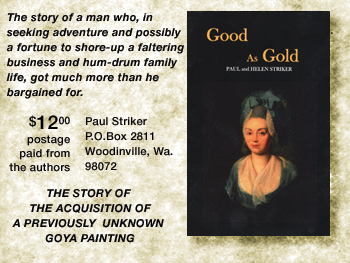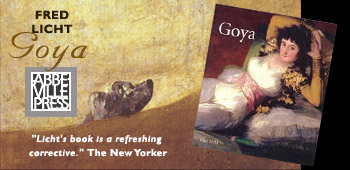GOYA BIRTHDAY
Born in Fuendetodos, near Saragossa, Spain on March 30, 1746. Died April 15, 1828 in Bordeaux, France.
Bio page here.

University of New Hampshire Hosts Goya etching exhibit of "Disasters of War"
The Paul Creative Arts Center at the University of New Hampshire is hosting an exhibit of Goya's "Disasters of War" etchings. A review is published in the student newspaper here.
From the review written by Michael Farrell:
 Here and there, the wall is interrupted by a sheet of scarlet red, and mounted on these walls. Hanging at regular intervals, are equally-sized, black and white visions of starvation, torture, murder, death and general inhumanity. Here and there, the wall is interrupted by a sheet of scarlet red, and mounted on these walls. Hanging at regular intervals, are equally-sized, black and white visions of starvation, torture, murder, death and general inhumanity.
It's depressing.
But in a world that struggles with the sorrows of 9/11, the genocide in Darfur, and the Iraq war, the exhibit strikes a resonate and emotional chord with many.
On Jan. 20 the UNH art gallery opened the famous, Napoleonic era painter, Francisco de Goya's, etchings series, "The Disasters of War."
"It's just so emotional," said gallery attendant, Tiffany Heineman, as she described a print that she found particularly poignant.
The print, titled "No se puede mirar" or "One can not look at this" in English, depicts a group of civilians who are about to be shot. A cloaked woman clutches her young child. A man kneels stiffly, presumably in prayer, bracing himself for the end. Another woman has her head thrown back and her arms extended at her sides and seems to wail in despair. A man in the foreground kneels before his executioners with his hands clasped, pleading for his life. And sticking out of the right side of the frame is a cluster of rifle muzzles with attached bayonets.
"I don't know if I could call it my favorite, but it's the one that shocked me the most," said Heineman.
Sean McGrimley, the gallery attendant that was watching over the "New Hampshire Art Association's 59th Annual Exhibition" downstairs, said of the Goya exhibit, "It's a downer for most people."
However, he also said, "I like it. It's just when you look at it you're like, 'Wow.
The exhibit is on the Durham campus of the University of New Hampshire, United States.
Web site of the Paul Creative Arts Center is here.
Lecture on Goya and the "Inimical Life" in Conneticut, USA, on March 6
Conneticut College is hosting Professor Ian Baucom, Professor and Chair of the English department at Duke University, for a free lecture (open to the public) at the Chu Reading Room in the Shain Library. The talk on Goya is the 2007 annual Lorna F. McGuire ´31 Lecture.
From the press release:
 Baucom will use the Goya paintings as a way to ask questions about sovereignty, realism, and those people excluded from the legal protection of the nation-state: brigands, bandits, and insurrectionaries, what he wants to call those who possess only "inimical life." Baucom will use the Goya paintings as a way to ask questions about sovereignty, realism, and those people excluded from the legal protection of the nation-state: brigands, bandits, and insurrectionaries, what he wants to call those who possess only "inimical life."
Baucom specializes in 20th century British literature and culture, postcolonial and cultural studies, and African and Black Atlantic literatures. He is the author of "Out of Place: Englishness, Empire and the Locations of Identity" (1999), "Specters of the Atlantic: Finance Capital, Slavery, and the Philosophy of History" (2005), and co-editor of "Shades of Black: Assembling Black Arts in 1980s Britain" (2005). He has edited special issues of the South Atlantic Quarterly on Atlantic Studies and Romanticism, and is currently working on a new book project tentatively entitled "The Disasters of War: On Inimical Life.
Connecticut College is in New London, Conn., the event is on March 6, 2007 at 4:30 p.m. in the Shain Library, Chu Reading Room. For information contact Eric Cárdenas (860) 439-2508; eric.cardenas@conncoll.edu
Web page about the event on the University web site here.

Gian Carlo Menotti, composer of 1986 Goya opera, has died
CBS News reports that Gian Carlo Menitti, the author and composer of many operas, has died at the age of 95. Menotti was the author of the 1986 opera based on Goya (titled "Goya") and starred Plácido Domingo. The CBS news obituary is
here. The Schirmer Menotti biography is here. The Palm Beach Post newspaper carries an obituary that particularly discusses the Goya opera here.
STOLEN GOYA FINALLY GOES ON DISPLAY
The Goya painting "Children with A Cart" which was stolen November 14, 2006 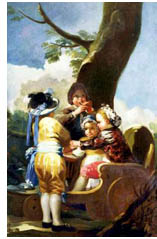 while en route to the Guggenheim exhibition Spanish Painting From El Greco to Picasso: Time, Truth and History and is now finally on display where it was originally intended. while en route to the Guggenheim exhibition Spanish Painting From El Greco to Picasso: Time, Truth and History and is now finally on display where it was originally intended.
 All's well that ends well," said Don Bacigalupi, director of the Toledo Museum of Art, who traveled to New York's Solomon R. Guggenheim Museum for the delayed installation of Goya's "Children with a Cart" there. All's well that ends well," said Don Bacigalupi, director of the Toledo Museum of Art, who traveled to New York's Solomon R. Guggenheim Museum for the delayed installation of Goya's "Children with a Cart" there.
The painting was being trucked to New York in November when the drivers spent the night at a motel in Stroudsburg, Pa., leaving it unattended. They discovered it missing the next morning. Within 10 days, a tipster had alerted authorities to its whereabouts in New Jersey.
FBI spokesman James Margolin said the investigation into the theft was ongoing.
The painting was insured for about $1 million. It was returned undamaged to the Toledo museum which owns it before being lent to the Guggenheim as originally planned for inclusion in the exhibit, "Spanish Painting from El Greco to Picasso: Time, Truth, and History."
"After the FBI recovered it, it went back to Toledo, Ohio to be enjoyed by the audience there and welcomed home, and then Don very graciously agreed to the loan for the next six weeks of the show," said Guggenheim Director Lisa Dennison.
The complete Nepa News story about this is here.
More info about the theft here.

SAMUEL GOLDWYN FILMS DISTRIBUTING "GOYA'S GHOSTS" FOR USA
 The long, long journey for the Milos Forman and Saul Zaentz bio-movie about Goya seems to be coming to an end, at least as regards getting the film to the United States. (Zaentz and Forman are the team that made the Mozart bio film "Amadeus") Goya's Ghosts has been playing in Europe for months, but United States showings were delayed while distribution was arranged. The long, long journey for the Milos Forman and Saul Zaentz bio-movie about Goya seems to be coming to an end, at least as regards getting the film to the United States. (Zaentz and Forman are the team that made the Mozart bio film "Amadeus") Goya's Ghosts has been playing in Europe for months, but United States showings were delayed while distribution was arranged.
See our extended page on the movie here.
The Hollywood Reporter has more of the story:
 The Saul Zaentz production, slated for a summer U.S. platform theatrical release, stars Bardem as a member of the clergy during the Spanish Inquisition who becomes obsessed with one of its targets, Goya's muse (Portman). The story follows their personal trials from the late 18th century through the tortured girl's release from prison after Napoleon's invasion of Spain. The Saul Zaentz production, slated for a summer U.S. platform theatrical release, stars Bardem as a member of the clergy during the Spanish Inquisition who becomes obsessed with one of its targets, Goya's muse (Portman). The story follows their personal trials from the late 18th century through the tortured girl's release from prison after Napoleon's invasion of Spain.
"Saul is not only a friend, but a wonderful filmmaker," said Samuel Goldwyn Films CEO Samuel Goldwyn Jr., who was shown the picture by Zaentz several months ago and finalized the deal last week. " 'Ghosts' is a love story and a violent political story and a wonderful woman's story about a fascinating period in history and the effect of the Inquisition's lives as seen through the eyes of Goya. I wish every film we had was as good as this.
Complete article here.
"CITIZENS AND KINGS" EXHIBIT INCLUDES GOYA'S "FERDINAND VII"
The Royal Academy of Arts is presenting the exhibit Citizens and Kings: Portraits in the Age of Revolutionfrom February 3, 2007 until April 20, 2007. A review of the exhibit at thisislondon.com by Brian Sewell is here:
 [Talking about Goya's Ferdinand VII] He, too, looks like a peasant togged up for a ball, but at least we know that Goya was capable of irony and the paint itself, particularly in the braiding of the cloak, is utterly seductive in the way that it represents alien materials while remaining indubitably fat impastose paint. Was Goya suggesting some ironic contrast between this ugly, fat-legged little man and the regal trappings of his position? Hanging Lawrence's portrait of George IV nearby was quite a witty thing to do, for the pose mirrors the Spanish king and George is hung with even heavier trappings, but where Ferdinand was deliberately stunted in proportion, George has been fined of fat and turned into eight feet of balletic fairy prince; Lawrence was, no doubt, aware of his duty and doing it; Goya, equally aware, was not.. [Talking about Goya's Ferdinand VII] He, too, looks like a peasant togged up for a ball, but at least we know that Goya was capable of irony and the paint itself, particularly in the braiding of the cloak, is utterly seductive in the way that it represents alien materials while remaining indubitably fat impastose paint. Was Goya suggesting some ironic contrast between this ugly, fat-legged little man and the regal trappings of his position? Hanging Lawrence's portrait of George IV nearby was quite a witty thing to do, for the pose mirrors the Spanish king and George is hung with even heavier trappings, but where Ferdinand was deliberately stunted in proportion, George has been fined of fat and turned into eight feet of balletic fairy prince; Lawrence was, no doubt, aware of his duty and doing it; Goya, equally aware, was not..
The Royal Academy of Arts page on the exhibit is here.

SAINT BERNARDINO OF SIENA UPDATED
The Goya painting of Bernardino of Siena from 1784 added here.

GOYA WEB SITE STATISTICS FOR JANUARY 2007: 115,317 Page Visits, 1,025,460 Hits
"DISASTERS OF WAR" AT THE UNIVERSITY OF NEW HAMPSHIRE
An exhibit of Goya etchings from the "Disasters of War" set are being presented at the Art Gallery of the University of New Hampshire beginning January 20th, with a preview on January 18th.
The University web site page about the exhibit here.
The University page about admission, directions and hours is here.

HUGHES' "GOYA" IN PAPERBACK
The Canada Nova Scotia Herald has a brief review of the new edition of Hughes 2003 book on Goya culled from the New York Times Review of Books:
 This is a moving, superbly illustrated study of the dark genius of Francisco de Goya y Lucientes (1746-1828), informed by the author’s own ghastly experience after a car crash. Hughes deconstructs Goya’s technique — his use of light and shadow, his framing of chaotic, sometimes surreal subject matter — and situates his work against Spain’s harrowing war with Napoleon. In The New York Times Book Review, Jenny Uglow called Hughes’ account "dazzling, disturbing and intensely personal": "We feel the painful immediacy of Goya’s work, as if we had one skin less. This is a moving, superbly illustrated study of the dark genius of Francisco de Goya y Lucientes (1746-1828), informed by the author’s own ghastly experience after a car crash. Hughes deconstructs Goya’s technique — his use of light and shadow, his framing of chaotic, sometimes surreal subject matter — and situates his work against Spain’s harrowing war with Napoleon. In The New York Times Book Review, Jenny Uglow called Hughes’ account "dazzling, disturbing and intensely personal": "We feel the painful immediacy of Goya’s work, as if we had one skin less.

ONGOING CONTRAVERSY OVER GOYA MICRO SIGNATURES
The Spanish language web site logopress.es has an article on Goya microsignatures by Maria Jesus Burgueño which discusses the ongoing controversy about disputed paintings attributed by some experts, and disavowed by others:
 Antonio Perales is the great defender of goya "microsignatures" in our country. Perales is a member of the Institute of Conservation and Restoration of Bienes Culturales (ICRBC), a technician in artwork restoration, and a specialist in “small horse painting”. This expert has developed an ultramodern theory to identify the work of Goya based on microsignatures. Opposing this theory is Manuela Mena, head of 18th century painting conservation at the Museum of the Prado. Each of these opposing opinions are supported by a number of followers and detractors. Antonio Perales is the great defender of goya "microsignatures" in our country. Perales is a member of the Institute of Conservation and Restoration of Bienes Culturales (ICRBC), a technician in artwork restoration, and a specialist in “small horse painting”. This expert has developed an ultramodern theory to identify the work of Goya based on microsignatures. Opposing this theory is Manuela Mena, head of 18th century painting conservation at the Museum of the Prado. Each of these opposing opinions are supported by a number of followers and detractors.
An author who agrees with the theory of Goya microsignatures is Augustín Herrán, who published several books between 1956 and 1962 on symbolism in Goya's work. Canadian expert Rolph Z. Medgessy spoke in support of microsignatures in the 1970s, and Paolo Erasmo Mangiante, a painting expert in Italy, also agrees with these theories.
It is a serious matter to have experts agree, for a disagreement can make the valuation of a piece drop from 1,200,000€ to only 2.000€ in a single morning. The world of art, and especially the world of the art market of sales and auctions, could undergo a revolution if pictures attributed as "anonymous" from the time of the brilliant Aragonese artist were to be catalogued as genuine 'Goyas.' 
The full article in English (via Google translation) here.
The article in original Spanish at logopress here.
I became aware of this article via the Goya attribution web site goyadiscovery here.
LUIS MARIA DE BORBON AND HIDDEN GOYA SIGNATURE
Goya's 1893 portrait of Luis Maria de Borbon is at the Museo del Prado for cleaning and its first ever public viewing (see news article for December 29, 2006, below). goyadiscovery.com, which is a site about research into Goya authenticity arguments and especially hidden signatures and graphisms in Goya's artwork, has a new page about this painting. See the screenshot below for an example:
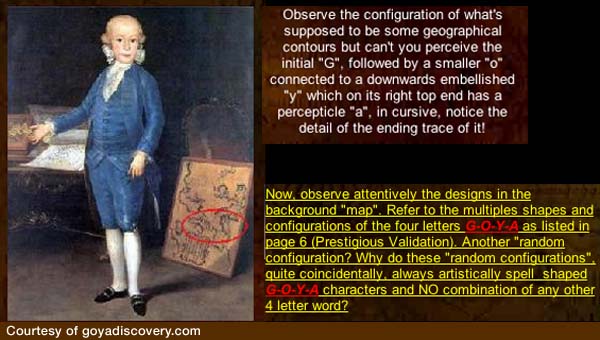
Be sure to look at the full article at goyadiscovery here.
GOYA'S PORTRAIT "LUIS MARIA de BORBON" ON VIEW FOR FIRST TIME
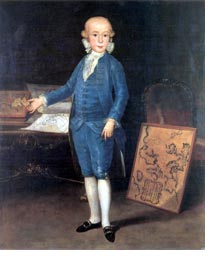 Never loaned for public exhibit, Goya's 1893 portrait of Luis Maria de Borbon is now at the Museo del Prado for public viewing and cleaning. The UK Guardian newspaper reports on this: Never loaned for public exhibit, Goya's 1893 portrait of Luis Maria de Borbon is now at the Museo del Prado for public viewing and cleaning. The UK Guardian newspaper reports on this:
 It is the portrait that everyone knew existed but few have been fortunate enough to see in the two centuries or so since it was painted. It is the portrait that everyone knew existed but few have been fortunate enough to see in the two centuries or so since it was painted.
Yesterday that painting of a cherubic-looking six-year-old member of the Spanish royal family, the Infante Don Luis Maria, was displayed to the world for the first time since Francisco de Goya put paintbrush to canvas in 1783.
But just as intriguing as the painting is the subject himself - an apparently studious little boy who would go on to become a cardinal at the age of 23 and who would put an end to that most infamous institution, the Spanish Inquisition.
The painting has been given to the Prado for conservation work but it will soon hang in the city museum in Zaragoza, central Spain - close to the town of Goya's birth, Fuendetodos. A new museum to house Goya paintings is be built in the city as part of an international Expo that it hosts in 2008.
According to Xavier de Salas' book on Goya, this oil on canvas painting measures 134 cm x 114 cm (52 3/4 inches by 45 inches).

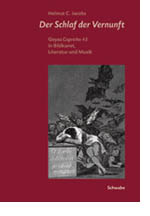 NEW BOOK ON GOYA NEW BOOK ON GOYA
The Sleep of Reason by Helmut C. Jacobs
Goyas Capricho 43 in picture art, literature and music
Published 2006. 681 pages with 101 illustrations
ISBN 978-3-7965-2261-1
Below is a description of the book from the Schwabe Publishers web site (translated from German to English):
 The investigation is divided into five parts. The first part is dedicated to developing the history, the structure and the content of the picture as an ambiguous text screen form. It shows us that the complex, strictly proportional screen layout is corresponding to several order principles, mutually related though contrasting to one another. In the second part the anthropological dimension is plumbed in Caprichos 43, not only regarding the gesture and body language of the sleeping figure, but also in view of Goya's conception of the universal language. In the center of the third part the term history and theory of the fantasy between reason and insanity are discussed. With this background the innovative artwork of Goya's conception of visual fantasy is determined. Uncontrolled fantasy forms the basis of a new aesthetic, a radical break with classic artistic conventions. The fourth part relates Caprichos 43 to pictures and texts and contemporary handwritten comments. In the fifth part the reception to Caprichos 43 as source of inspiration for new works of art is discussed, from 1799 to the present. These includes not only picture art, literature and essays to the present, but also music, film and recent digital media. The investigation is divided into five parts. The first part is dedicated to developing the history, the structure and the content of the picture as an ambiguous text screen form. It shows us that the complex, strictly proportional screen layout is corresponding to several order principles, mutually related though contrasting to one another. In the second part the anthropological dimension is plumbed in Caprichos 43, not only regarding the gesture and body language of the sleeping figure, but also in view of Goya's conception of the universal language. In the center of the third part the term history and theory of the fantasy between reason and insanity are discussed. With this background the innovative artwork of Goya's conception of visual fantasy is determined. Uncontrolled fantasy forms the basis of a new aesthetic, a radical break with classic artistic conventions. The fourth part relates Caprichos 43 to pictures and texts and contemporary handwritten comments. In the fifth part the reception to Caprichos 43 as source of inspiration for new works of art is discussed, from 1799 to the present. These includes not only picture art, literature and essays to the present, but also music, film and recent digital media.
The author
Helmut C. Jacobs, born 1957 in Bonn, Germany, studied in Bonn and Toulouse Germanistik and Romanistik (graduation 1987, Habilitation 1995) and is since 1997 professor for Romanistik/Literaturwissenschaft with the emphasis French and Spanish at the University of Duisburg meal. Main points of research: Kurznarrativik of the Roman Middle Ages, literature as well as aesthetics of the French, Italian and Spanish clearing-up, literature and music in their interrelations, picture and text - theory and practice of the emphasis in the Roman literatures.
The publisher's web site page announcing this book is here (in German).
I asked the author about this book (via e-mail), and Mr. Jacobs said:
 ...A Spanish translation [of the book] is in preparation. The Capricho 43 is one of the most important pictures of the Spanish culture. All is focused to this picture and its variability of senses and interpretations. I explain the tradition and the sources for Goya, but also the reception of the Capricho 43 in the arts in the following two centuries. I present a lot of new interpretations of the complicated structure of the Capricho, the interpretation of the enigmatic motto (El sueno de la raz—n produce monstruos), and many other solutions to read and to understand the picture. ...A Spanish translation [of the book] is in preparation. The Capricho 43 is one of the most important pictures of the Spanish culture. All is focused to this picture and its variability of senses and interpretations. I explain the tradition and the sources for Goya, but also the reception of the Capricho 43 in the arts in the following two centuries. I present a lot of new interpretations of the complicated structure of the Capricho, the interpretation of the enigmatic motto (El sueno de la raz—n produce monstruos), and many other solutions to read and to understand the picture. 

GOYA PAINTING PULLED FROM AUCTION IN MADRID 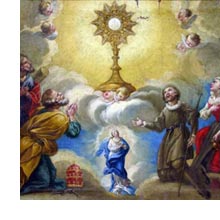
Multiple news sources are reporting that an art auction at the Lamas Bolaño art house in Madrid, Spain featuring a controversial Goya painting 'Santos Adorando el Santísimo Sacramento' has been pulled and taken to the Museo del Prado for authentication:
From the artdaily.com web site:
 The “Saints Adoring the Holy Sacrament” attributed to Goya was scheduled to be auctioned yesterday at Lamas Bolaño, in Madrid. But the police withdrew it from the auction and took it to to Museo del Prado to be examined by experts, according to a spokesperson from the Ministry of Culture. The work had a starting price of 1.2 million euros. The “Saints Adoring the Holy Sacrament” attributed to Goya was scheduled to be auctioned yesterday at Lamas Bolaño, in Madrid. But the police withdrew it from the auction and took it to to Museo del Prado to be examined by experts, according to a spokesperson from the Ministry of Culture. The work had a starting price of 1.2 million euros.
Carmina Pertierra, responsible of the auction house, stated the work is in the Museo del Prado offices to be examined. The Prado has not confirmed this. The work measures 57 x 70 cm and belongs to a private collector and has a certificate of authenticity issued by José Manuel Arnáiz y Asociados and a chemical analysis of the pigments signed by Enrique Parra. There are also x-rays of the work and a technical study by Antonio Perales.
Long time readers of this web site will notice the mention of Professor Antonio Perales, Goya researcher and authentication expert. Pages about Dr. Perales work is on this web site here.
From the typicallyspanish.com web site:
 A Goya painting has been withdrawn from auction following doubts about its authenticity. ‘Santos Adorando el Santísimo Sacramento’ had an opening price of 1.2 million € in the sale planned in Lamas Bolaño. A Goya painting has been withdrawn from auction following doubts about its authenticity. ‘Santos Adorando el Santísimo Sacramento’ had an opening price of 1.2 million € in the sale planned in Lamas Bolaño.
Administrator of the sale, Arturo Guinovart, said that there were doubts with respect to the painting’s authenticity.
The work measures 57 X 70 cms and is owned by a resident of Madrid. It was taken by the Historical Heritage unit of the Ministry of the Interior police last Friday, and it’s unknown how long their investigations will continue.
El Pais.com reports on the story (translated from Spanish):
 ...Police of the Department of the Interior removed the picture Friday, according to comments of Carmina Pertierra, the person in charge at Lamas Bolaño. He was surprised and said he did not know if there had been a denunciation. The auction was suspended because “it is not known how long is going it to have the police”, explained Pertierra, “they are giving it to be examined by the conservators at the Museum Prado”. ...Police of the Department of the Interior removed the picture Friday, according to comments of Carmina Pertierra, the person in charge at Lamas Bolaño. He was surprised and said he did not know if there had been a denunciation. The auction was suspended because “it is not known how long is going it to have the police”, explained Pertierra, “they are giving it to be examined by the conservators at the Museum Prado”.
Representatives at the museum of the Prado said it is not an unusual practice that the police takes part if doubts exist on a pictures authenticity. The art house Lamas Bolaño supports the attribution of the picture to Goya, supported by information and certificates, contributed by the proprietor, made by the historian of the art Jose Manuel Arnáiz, of the Training center Pinacológicos.
Documentation includes a chemical pigment analysis made by Enrique Parra Crego, as well as x-rays of the picture and technical study by Antonio Perales Martinez, documentation that was given to the police, said Pertierra.

REVIEW OF GOYA EXHIBIT "MONSTERS AND MATADORS" IN SCOTLAND
The Scottish newspaper The Scotsman has a review of the National Gallery of Scotland Goya exhibit:
 Goya was not a happy man. Not if the collection of prints currently on show at the National Gallery are anything to go by. Goya was not a happy man. Not if the collection of prints currently on show at the National Gallery are anything to go by.
But it was not always that way. His earlier works were of happier, or at least considerably less controversial scenes than depicted in this often violent collection.
Made up of three out of four series of prints made by the artist in the later years of his life. The first, The Disasters of War, chronicles events of the Peninsular War in the early 19th century, during which Spain was occupied by Napoleon's armies.
The second, The Tauromaquia, is a history of bullfighting from its origins in hunting to its development by the Moors as a sport.
The third, The Proverbios or Follies, is a series of observations on the human condition in general, appearing to highlight the absurdities, contradictions and follies of mankind.
None of the prints in any of the series could be described as easy to look at from an emotional point of view. Stark, vivid depictions of matadors being gored by bulls, or soldiers, having previously been mutilated, being hung on trees by their enemies as a warning to others who might follow their example.
Even the slightly lighter hearted Follies series features a grotesque embodiment of lust, towering over a young couple, and a hideous mutation of two people - seen as a single, horrific entity, locked as they are in an undesired arranged marriage.
Goya was a liberal, very angry man in his later years. His politics came to the fore in the Disasters of War series, as he railed against war, it's practitioners and it's atrocities, those of his own country included. He was clearly against bullfighting, since the bull itself is always portrayed as a noble and proud beast, set upon by men with dogs, spears (some with firecrackers embedded in them) and swords, maniacally attacking the animal, ultimately for no good reason.
The follies are less easy to interpret, and it has been theorised that they represent proverbs in common usage at the time, thus the collective title, The Proverbios. These prints have a surreal and macabre quality, reminiscent of his well known 14 Black Paintings series. Each series clearly shows, in its own fashion, Goya's dissatisfaction with his own kind, shown as they are as ignorant, corrupt and contemptible.
The complete review "Goya is a master of disaster" by Martin Lenon is on the Scotsman web site here.
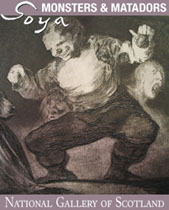 NATIONAL GALLERY OF SCOTLAND PRESENTS GOYA ETCHING EXHIBIT NATIONAL GALLERY OF SCOTLAND PRESENTS GOYA ETCHING EXHIBIT
From December 16, 2006 to April 25, 2007 the National Gallery of Scotland will present Goya: Monsters and Matadors featuring 42 etchings from the Disasters of War, the Tauromaquia, and the Proverbios (or Disparates) etching series.
National Gallery of Scotland page on the Goya exhibit
- Exhibit held at:
National Gallery of Scotland,
The Mount, Edinburgh,
EH2 2EL
Admission will be free for the event.
- Enquiries: Hannah Brocklehurst
Telephone: +44 (0)131 624 6593
Email: hbrocklehurst@nationalgalleries.org
GUGGENHEIM MUSEUM: Spanish Painting from El Greco to Picasso: Time, Truth, and History
This painting exhibit at the Guggenheim certainly started off with a great deal more publicity than is usual: one of the Goya paintings meant for the collection, Children with a Cart, was stolen en route to be delivered. (See news stories here). The painting was recovered, but the story played all around the world. Now that the exhibit is actually open, reviews of the event are beginning to appear:
 Five centuries of art is a lot of art, especially when so much of it is of such high quality. But "Spanish Painting" is surprisingly helped by its college-survey-course size. Five centuries of art is a lot of art, especially when so much of it is of such high quality. But "Spanish Painting" is surprisingly helped by its college-survey-course size.
The Guggenheim has been able to assemble so many fine works and then arranged them non-chronologically, setting up unusual juxtapositions, so that you can pleasantly roam Frank Lloyd Wright's spiral and marvel at how similar in feeling, say, Picasso's "Two Seated Children (Claude and Paloma)," done in 1950, is to Juan Pantoja de la Cruz's 1607 "The Infanta Don Felipe and Doña Ana."
This effect is often amusing, especially since this show adds up to a kind of short list of legendary artists who appear and reappear again and again: Picasso, Dali, Goya, Murillo, Ribera, the austere Zurbaran, and of course Velázquez -- the Spanish canon, you might say.
Organized by Guggenheim curator Carmen Giménez and hung with studied care, "Spanish Painting" is a remarkably self-conscious show.
The first big bay on the ramp, for example, is given over entirely to Zurbaran and his pictures of monks, both the simplified single portraits that make them, in their pointed hoods, look like high-caliber bullets, and his slightly less formal group pictures like "Saint Hugh in the Refectory (Saint Bruno and the Miracle of the Uneaten Meat)" (believe me, you don't want an explanation of the parenthetical). They are meant to stand in for the ascetic in Spanish art, along with a handful of gory Baroque spectacles and modern cruelties upstairs, like José de Ribera's "Apollo and Marsyas" and the handful of Picasso's crucifixions scattered in one of the off-ramp galleries.
Spanish art is often categorized as gloomy, mystical, and bloody, and this show does little to dispel that stereotype. It's also thought to be a solemn, dark exercise in which Dali's and Picasso's blues and golds shout among the purples and the dusky reds of Spanish history, and that, too, is confirmed by this show. The Goyas that made it here (including "Children With a Cart," the painting stolen on the way to the show, ultimately found in New Jersey, and sent back to Spain) are a slight exception. Two Goya tapestry paintings of little children, "Boy on a Ram" and "Boys Playing at Soldiers," flank Picasso's "The Young Bullfighter" and more than hold their own in the lightness contest. But almost everywhere else, dignity lies on this art like a heavy jeweled necklace.
Since the painting in question, Children with a cart, was originally being borrowed from the Toledo, Ohio, Museum of Art, perhaps the writer (Dan Bischoff at the New Jersey Star-Ledger) means it was returned to the original museum?
WEB SITE STATS
This site had 26,911 unique visitors in November. They viewed 104,259 pages. That brings our totals for the year of 2006 to 197,140 visitors and 761,716 pages. The most popular page is the one on the Goya painting Saturn.
"GOYA'S GHOSTS" MOVIE OPENING SCHEDULE
 The IMDB web site carries a schedule (also a number of "readers" reviews" which are generally very positive) for the Milos Forman bio film about Goya; however, no set date is given for the United States. It was expected to open before the USA Christmas holiday season for the North American theatre market, but is now apparently being pushed into 2007. I contacted Hanway Films, which is the production company for the movie, and below are the release dates for the film which they can confirm: The IMDB web site carries a schedule (also a number of "readers" reviews" which are generally very positive) for the Milos Forman bio film about Goya; however, no set date is given for the United States. It was expected to open before the USA Christmas holiday season for the North American theatre market, but is now apparently being pushed into 2007. I contacted Hanway Films, which is the production company for the movie, and below are the release dates for the film which they can confirm:
[To view our page on the movie, including older news stories and some photographs, go here)
Spain November 8, 2006
Germany November 23, 2006
Austria November 24, 2006
Switzerland "French section" January 1, 2007
Switzerland "German Section" November 23, 2006
Switzerland "Italian Section" February 2, 2007
Greece January 11, 2007
Italy January 19, 2007
Czech Republic February 1, 2007
Denmark February 2007 (to be confirmed)
Slovenia, Croatia, Bosnia Feb/ Mar 2007
Netherlands April 12, 2007
Former Yugoslavia March 15, 2007
Poland March 23, 2007
CIS / Baltic States April6, 2007
France April 2007
Portugal May 31, 2007

STOLEN GOYA RECOVERED
A number of news outlets are carrying the story about the  Goya painting "Children with A Cart" which was stolen November 14 while en route to the Guggenheim exhibition
Spanish Painting From El Greco to Picasso: Time, Truth and History. The painting was recovered November 20. From the story at the CBS news web site: Goya painting "Children with A Cart" which was stolen November 14 while en route to the Guggenheim exhibition
Spanish Painting From El Greco to Picasso: Time, Truth and History. The painting was recovered November 20. From the story at the CBS news web site:
 Steven Siegel, a spokesman for the FBI, said the bureau recovered the painting Saturday in New Jersey, but would not be more specific about where or how it was located. No arrests were made, but the case remains under investigation, he said. Steven Siegel, a spokesman for the FBI, said the bureau recovered the painting Saturday in New Jersey, but would not be more specific about where or how it was located. No arrests were made, but the case remains under investigation, he said.
The FBI said extensive news coverage of the theft led to tips that enabled the agency to recover the painting.
The painting was taken from an art transporter's truck that was parked overnight in a hotel parking lot in Stroudsburg, Pa., on Nov. 8, authorities said. It had been scheduled to be displayed in the exhibition "Spanish Painting from El Greco to Picasso: Time, Truth, and History," which opened at the Guggenheim on Nov. 17.
Siegel said the thieves apparently did not know what was inside the truck when they broke into it. "It was a target of opportunity. They probably thought it was a truck full of PlayStations," he said.
The image of four children at play was insured for about $1 million and was to be exhibited with about 135 paintings by Spanish masters.
[Below: News items from when the story first occurred]
FEDERAL INVESTIGATORS: GOYA THEFT AN "INSIDE JOB"
According to a November 18 piece at the New York Times by David Johnston, the recent theft of Goya's "Children With A Cart" is being attributed to "inside knowledge." A reward of $50,000 USD is being offered by the insuring company. Officials at the Toledo Museum of Art and at the Guggenheim Museum, who were planning to include the painting in “Spanish Painting From El Greco to Picasso: Time, Truth and History,” are referring questions to the F.B.I.
 The 1778 painting, “Children With a Cart,” was packed inside several nested crates aboard a locked unmarked truck used by a professional art transporter. The crated painting was removed from an outer shipping container in the truck while it was parked at a Howard Johnson Inn near Bartonsville, Pa. The 1778 painting, “Children With a Cart,” was packed inside several nested crates aboard a locked unmarked truck used by a professional art transporter. The crated painting was removed from an outer shipping container in the truck while it was parked at a Howard Johnson Inn near Bartonsville, Pa.
The two drivers checked into the hotel around 11 p.m. on Nov. 7, according to the motel manager, Faizal Bhimani. He said the white midsize truck was left in an unlighted parking lot adjacent to the hotel, out of sight of the hotel’s rooms and the main office.
When the drivers returned to the truck at about 6:30 a.m. on Nov. 8, the locks had been broken and the painting, insured for $1 million, was gone, law enforcement officials said, speaking on condition of anonymity. Mr. Bhimani said the hotel’s night clerk had neither seen nor heard anything suspicious.
...Investigators have conducted extensive interviews with the drivers, asking, among other questions, why they left the truck unattended when operating procedures for most art transport companies require that trucks carrying valuable art objects never be left unattended.
Investigators have also asked the drivers why they stopped overnight on a trip that could have been completed in a single day. Officials said the drivers replied that they were scheduled to arrive in Manhattan around midday on Nov. 8 and did not want to arrive too early and wait in New York until the assigned time.
The article also includes interesting information about the methodology of shipping expensive and rare art works:
 Thomas J. Carney, president of Midwest Fine Arts Service and Transportation, a company based in Berea, Ohio, that did not ship the Goya, said reputable shippers normally exercise great care in handling and shipping fine art and antiquities. Thomas J. Carney, president of Midwest Fine Arts Service and Transportation, a company based in Berea, Ohio, that did not ship the Goya, said reputable shippers normally exercise great care in handling and shipping fine art and antiquities.
He said trucks with multiple locks are monitored by satellite, which records the location of the vehicle, whether the engine is on or off, and even how fast the engine is running. However, individual artworks are not usually tagged with tracking devices, he said.
Drivers are often subjected to background checks, Mr. Carney said, and information about shipments is limited to a few people in each company. Shipments are usually accompanied by two drivers, and sometimes by a third person, a courier, who rides along to make sure the cargo is safe. Shipping documents are kept intentionally vague to avoid disclosing the precise nature of the cargo.
“Usually only two or three people at a museum know what it is being shipped,” Mr. Carney said. “A shipping broker would know. A dispatcher would only know there is an order, but we wouldn’t even say who the artist is.
[Below] I noticed that in Spain, the Goya theft was front page news:
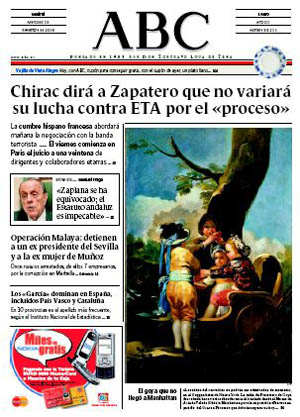
[Below] The original November 14 news item referring to the theft:
GOYA'S "CHILDREN WITH A CART" STOLEN EN ROUTE TO GUGGENHEIM MUSEUM
The work was intended to join the collection assembled by the Guggenheim for the exhibit titled Spanish Painting from El Greco to Picasso: Time, Truth, and History. An article at the Ohio Toledo Blade mentions what happened:
 The piece, Children with a Cart, was insured for just over $1 million and was in the hands of a professional art transporter when it was snatched Wednesday in the Scranton, Pa., area. The transport vehicle was unattended at the time of theft, said Jerri Williams, spokesman for the FBI's Philadelphia division, which is leading the investigation. The piece, Children with a Cart, was insured for just over $1 million and was in the hands of a professional art transporter when it was snatched Wednesday in the Scranton, Pa., area. The transport vehicle was unattended at the time of theft, said Jerri Williams, spokesman for the FBI's Philadelphia division, which is leading the investigation.
...Children with a Cart was acquired by the Toledo Museum of Art in 1959. It's part of a series of paintings that Goya - whose full name is Francisco de Goya y Lucientes - made for the Royal Tapestry Factory of Santa Barbara in Spain illustrating a variety of fashions popular in the late 18th century.
The painting was being loaned to the Guggenheim Museum for its exhibition, "Spanish Painting from El Greco to Picasso: Time, Truth, and History," which opens Friday.
It's believed to be the first piece of art the Toledo museum has lost to theft in its 105-year history, said Jordan Rundgren, spokesman for the museum, which announced the theft late yesterday afternoon.
Ms. Rundgren said it would be impossible to find a legitimate buyer for the work. She said the theft would not change the museum's policy of loaning works.
Nearly one year ago, on Nov. 18, 2005, paintings by Andy Warhol and Jackson Pollock were stolen in a sophisticated heist from the Everhart Museum in Scranton.
"At this point there's no reason to believe it's anything more than a coincidence," said FBI agent Williams, who would not reveal the name of the company transporting the piece.
Anyone with information about the theft can report it to the FBI's Philadelphia division at 215-418-4000..
The Toledo Blade newspaper story on this is here.
The Guggenheim: El Greco to Picasso exhibit page is here.
The Toledo Museum Web Site page is here.
PODCAST: SARAH SYMMON'S GOYA LECTURE FROM EDINBURGH
As noted a few times in the news page here, Dr. Symmons provided a lecture at the Talbot Rice Theatre, University of Edinburgh Scotland on Saturday, 11th November 2006. The lecture was on Raeburn and Goya: The Redefining of Artistic Personality. This event itself was titled "Raeburn and his printmakers" at National Gallery of Scotland, Edinburgh. Dr. Symmon's lecture has been recorded to be added to the podcast lecture files which are on Symmon's web site (here). I asked her about the lecture event itself, and she mentioned in an e-mail:
"The Edinburgh lecture went very well... The Lecture was one of a number of papers given on European portraiture in relation to specifically the portraiture of the rather obscure Scottish portrait artist Henry Raeburn. There were representatives from the United States, from the Louvre in Paris and French universities as well as from many museums in the UK. I was the only Goya scholar and I spoke about the importance of Goya's portraits for the 19th century and how he and British portraitists like Raeburn, Gainsborough and Reynolds really kept the art of portraiture alive throughout the rather dead period of portraiture which succeeded them in the 19th century. I spoke about the popularity of Goya's portraits among American artists like Whistler and Sargent, and how the great portraitists from the European enlightenment transformed the art of portraiture so that even today painters are still finding their work inspirational. "
Dr. Symmons also mentioned the lecture may appear in published form at some point.
• Sarah Symmons Web Site
• Talbot Rice Theatre web page and current events page
INTERVIEW WITH "GOYA'S GHOSTS" DIRECTOR
The director of the film Milos Forman talks about the movie with writer Mateo Sancho Cardiel at Expatica magazine:
 After seven years of absence from the big screen, Oscar-winning After seven years of absence from the big screen, Oscar-winning 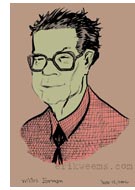 Czech director Milos Forman - of 'One Flew Over the Cuckoo's Nest' and 'Amadeus' fame - is a bit nervous about how his new movie about Francisco de Goya will be received in the great master's homeland. Czech director Milos Forman - of 'One Flew Over the Cuckoo's Nest' and 'Amadeus' fame - is a bit nervous about how his new movie about Francisco de Goya will be received in the great master's homeland.
"I'm afraid I might disappoint the Spanish people," the 74-year-old long time U.S. resident said in a telephone interview from his home in New York.
He was talking about 'Goya's Ghosts,' which is set for release on 10 November, and was filmed in and around Madrid in English and starring Javier Bardem and Natalie Portman.
Forman said he became fascinated with Goya, who died in 1828 and is renowned for his works portraying Iberian strife as well sublime depictions of royals, after visiting the Prado Museum in Madrid in the 1980s.
He said he began research on "this person able to give expression to two worlds as distinct as those of portrait of the royal family and those of the Black Paintings".
Late in his life, Goya used oils to paint directly onto the plaster walls of his home, called La Quinta del Sordo, making 14 works that have come to be known as the 'Black Paintings' somewhat dark or gloomy pieces seen by many to represent a shady side of existence.
Forman said he found in the historical period covered by the new film parallels with the persecution rampant in his native Czechoslovakia "when I still lived there."
That was in the 1960s, when the Communist repression of the Prague Spring in 1968 found him working on a project in Paris.
For more on the film, go to our page on Goya's Ghosts here.
"GOYA'S GHOSTS" FILM OPENING IN MADRID
The Washington Post newspaper carries a Reuters article by Elisabeth O'Leary about the opening of the Milos Forman film "Goya's Ghosts" (the dubbed Spanish title is Los Phantasmas de Goya) this week in Madrid, Spain. (To see our page on this movie, go here.)
  Forman said he chose Portman at first because he thought she looked like a Goya portrait, The Milkmaid of Bordeaux. Forman said he chose Portman at first because he thought she looked like a Goya portrait, The Milkmaid of Bordeaux.
But then he saw the film "Closer" and decided the actress, had enough of a range to play what are effectively three different characters in the film.
Goya himself (played convincingly by a low key Stellan Skarsgard) lived to be 82. He had gone deaf by the age of 46.
He witnessed and painted a gruesome period of European history -- the Inquisition, the French invasion of Spain and the restoration of the monarchy in Madrid by the British.
Goya's paintings depict different social strata over that tumultuous period and it is that role as a faithful observer of history that Forman focuses on, with all the grotesque and brilliant detail for which the painter became famous.
"Of course, because I'm Spanish, I assumed I'd be playing the role of Goya. It seemed the natural thing," award-winning Spanish actor Bardem said in the production notes of the film.

ROYAL ACADEMY OF ARTS IN LONDON PRESENTS FOUR GOYA PAINTINGS
The Royal Academy is hosting an exhibit titled "Citizens and Kings: Portraits in the Age of Revolution" which features 145 pieces, four by Goya. The exhibit will open February 3 and run until April 12, 2007.
Royal Academy of Arts exhibit page
UK Guardian newspaper article about the exhibit
- Royal Academy of Arts
Burlington House
Piccadilly
London W1J 0BD
Registered Charity No. 212798
- Telephone 020 7300 8000
Recorded information line 020 7300 5760/1
Disabled parking and wheelchair booking 020 7300 8028
General access enquiries (limited service) 020 7300 5732
access@royalacademy.org.uk
Hours: 10am-6pm everyday except Friday (last admission to galleries 5.30pm)
10am-10pm Friday (last admission to galleries 9.30pm)

This web site at 109,798 page visits for month of October
If you would like to review more stats about this site go here.
SARAH SYMMON'S GOYA LECTURE
Dr. Sarah Symmons will provide a lecture at the Talbot Rice Theatre, University of Edinburgh Scotland on Saturday, 11th November. The lecture is on Raeburn and Goya: The Redefining of Artistic Personality. This event is a part of the exhibition "Raeburn and his printmakers" at National Gallery of Scotland, Edinburgh. The lecture will be recorded and added to the podcast files on her website. I wrote to Dr. Symmon's to ask about the upcoming lecture and she mentioned in reply:
"Robert Rosenblum is coming as well as a number of other distinguished American and French scholars but I appear to be the only Goya voice in the whole thing so I hope I get a good audience. "
For information about reaching the theatre: Tel: 0131 650 2210 / 2211; email: info.talbotrice@ed.ac.uk
• Sarah Symmons Web Site
• Talbot Rice Theatre web page and current events page
CAPRICHOS 9th EDITION SET AUCTIONS FOR $18,400 USD
From the August auction at juliaauctions, Catalog description below:
FRANCISCO JOSE DE GOYA Y LUCIENTES (Spanish, 1746-1828) “LOS CAPRICHOS”. Rare and complete set of 80 plates bound into a volume with plate No. 1 as cover. We believe this to be the Ninth Edition, made in the Calcografia for the Real Academia 1908-1912. The edition was limited to 180 copies and was issued in a cream pasteboard cover with self portrait on the front. PROVENANCE: Ex-Collection, Library of Waldo Peirce. Each page measures 13-1/2” x 9-1/2”. SIZE: Book is 13-3/4” x 10-1/2”. CONDITION: Binding has splits, the plates have varying degrees of foxing. There are no tears and the images are bold and clear. A catalog from the Calcografia Nacional Madrid dated 1908 accompanies lot. 9-70767 (10000-20000)
GOYA PAINTING "COUNT FLORIDABLANCA" ADDED
This painting is considered to be Goya's first important commission from 1783. Page here.
GOYA AND THE USE OF MIRRORS
A new short article on Goya's use of mirrors in his artwork is here.
CAPRICHOS #55 & WOMAN WITH SCYTHE AND SERPENT ADDED
A page on Caprichos #55 here and the 1787 Goya etching Woman and Scythe here.

 GOYA AT THE OSAKA MUSEUM, JAPAN GOYA AT THE OSAKA MUSEUM, JAPAN
A traveling exhibit from the Prado in Spain is showing in Osaka, Japan. Titled "From Titian to Goya - Museo del Prado Masterpieces at Municipal Museum of Osaka" the exhibit contains numerous pieces Goya and many other artists from the Prado collection.
Artdaily has a four page portfolio of images showing some of the pieces that are a part of this exhibit here.
The Osaka Museum web site is here.
 GOYA'S GHOSTS UPDATE GOYA'S GHOSTS UPDATE
It appears that Warner Brothers will be distributing Goya's Ghosts for the United States market. There is not any mention of this on the Warner Brothers web site (warnerbros.com) nor any news of a schedule for release (I have contacted Hanway films, the production company that made the movie, but they've not replied to my query yet).
Stellan Skarsgard (the actor who was cast as Goya in the film) has an unofficial web site with a number of large photographs from the production set, including himself, Natalie Portman, and Randy Quaid (who was cast as King Carlos IV).

Stellan Skarsgard web site on the Goya movie
The website www.stellanonline.com is an "unofficial" home page for the actor who stars as Goya in the upcoming Goya's Ghosts film. It has some information about the film, along with a plethora of photographs.
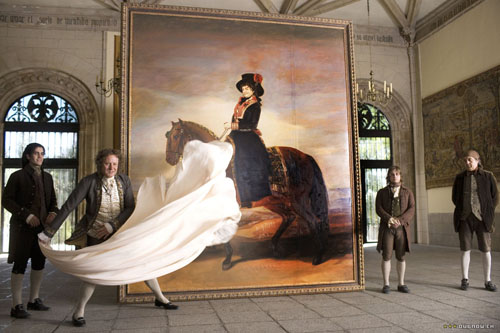

 GOYA The Second of May and The Third of May Updated GOYA The Second of May and The Third of May Updated
We have updated the pages on these two famous Goya paintings, and have added links to significantly larger images for viewing.

Goya's Third of May - Retribution and Justice
An article titled "Violence in European Paintings" by S. A. Khan was published in the Bangadesh New Nation on September 17, 2006 (here) includes a novel interpretation of Goya's Third of May. Khan is a member of the faculty at the Presidency University at Dhaka, in Bangladesh. (The article also includes analysis of art by Delacroix' Liberty Leading the People and Gericault’s The Raft of the Medusa.)
 In The Third of May 1808, Francisco de Goya painted an event that took place on the second and third of May1808, when the citizens of Madrid rose up against the French invaders and received on the following day a swift and barbarous retribution (Honour, 602). On the left of the painting, a group of unarmed civilians kneeling in a mingled pool of blood and dead bodies, backed against a mound and facing a firing-squad; members of the firing squad, on the right, are ready and committed to carry out the executions; a group of spectators have gathered past the condemned and the executioners to witness the event. The dark sky in the background is sad and gloomy, and a palace looks lifeless and has lost all its grandeur. The only illumination in the painting comes from a lantern at the feet of the soldiers. In The Third of May 1808, Francisco de Goya painted an event that took place on the second and third of May1808, when the citizens of Madrid rose up against the French invaders and received on the following day a swift and barbarous retribution (Honour, 602). On the left of the painting, a group of unarmed civilians kneeling in a mingled pool of blood and dead bodies, backed against a mound and facing a firing-squad; members of the firing squad, on the right, are ready and committed to carry out the executions; a group of spectators have gathered past the condemned and the executioners to witness the event. The dark sky in the background is sad and gloomy, and a palace looks lifeless and has lost all its grandeur. The only illumination in the painting comes from a lantern at the feet of the soldiers.
Initial observation arouses sympathy in our heart for the helpless men who are facing death, but careful analysis would help us understand that perhaps they do not deserve sympathy. Instead, these men are facing justice; the table of oppression has turned against them! A monk among the condemned civilians reminds us vividly of the Spanish Inquisition. Spain bathed in death and destruction, but the time has come for them to meet their fate. Goya did not show us the faces of the executioners—i.e., their identity-- because it is unimportant who is carrying out justice. Some may think those are French soldiers, but their uniforms and high hats (French soldiers wore hats with a flattened brim in front and back) do not support such view.
The civilians witnessing the execution appear to be neutral, participating in neither invasion nor in the uprising; thus, they are innocent. However, in realty, these men are treacherous individuals who benefited from being Spaniards but refused to help the motherland. Now come the cowards to witness the death of the Spanish heroes. The guilt in these weaklings is constant and as a result, they cannot make direct eye contact with the condemned men or the soldiers; one of them looks at the event through a hesitant side-glance while the others have covered their eyes with shame.
Finally, Goya, the great Spanish painter, focuses the lone lantern on the people who are dead or would be dead shortly. Therefore, it would be reasonable if we conclude the essence of this painting is death and the horror.

UK Times Interview with Goya writer Robert Hughes
A September 17, 2006 interview (which mentions a possible BBC Goya movie) with Robert Hughes (see our page on Hughes & his Goya book here) is online at the UK Times here.

Leonard Baskin's etching "Portrait of Goya" in St. Petersburg
Exhibit through October 29, 2006. Information, call (USA) 727-712-5762
American artist Leonard Baskin (1922-2000) is presented in a selection of works in exhibit at the Leepa-Rattner Museum in St. Petersburg, Florida, USA. Includes Baskin's etching portrait of Goya. The museum web site is here and a review of the exhibit by Lennie Bennet is here.
 Caprichos Exhibit at Braithewaite Fine Arts Gallery in Cedar City, Utah
September 21, 2006 – November 11, 2006. Over 100 pieces on exhibit including 80 Caprichos prints and single prints from Los Desastres de la Guerra, Los Proverbios, La Tauromaquia and one piece after Velazquez. From Landau Traveling Exhibits. Read about the traveling exhibit at a-r-t.com, and the Braithwaite Gallery at suu.edu

Goya's Ghosts movie still without distributor for theatre release
[UPDATE: It appears Warner Brothers will be distributing Goya's Ghosts for the United States market] The website moviecitynews.com has an article titled "29 weeks to Oscar" which mentions the current state for the Milos Forman/Saul Zantz Goya movie:
 The directors I foresee racing are still pretty much familiar awards season names, but a lot of those directors' films have simply become also-rans, some even without being seen. Just a couple of for-instances would be Milos Forman's Goya's Ghosts, which still has no distributor, and Scorsese's The Departed, which is now being positioned as an action movie first and awards movie not at all. The directors I foresee racing are still pretty much familiar awards season names, but a lot of those directors' films have simply become also-rans, some even without being seen. Just a couple of for-instances would be Milos Forman's Goya's Ghosts, which still has no distributor, and Scorsese's The Departed, which is now being positioned as an action movie first and awards movie not at all. 
Our page on the film Goya's Ghosts is here.
 |
 while en route to the Guggenheim exhibition Spanish Painting From El Greco to Picasso: Time, Truth and History and is now finally on display where it was originally intended.
while en route to the Guggenheim exhibition Spanish Painting From El Greco to Picasso: Time, Truth and History and is now finally on display where it was originally intended.


 Never loaned for public exhibit, Goya's 1893 portrait of Luis Maria de Borbon is now at the Museo del Prado for public viewing and cleaning. The
Never loaned for public exhibit, Goya's 1893 portrait of Luis Maria de Borbon is now at the Museo del Prado for public viewing and cleaning. The  NEW BOOK ON GOYA
NEW BOOK ON GOYA 
 NATIONAL GALLERY OF SCOTLAND PRESENTS GOYA ETCHING EXHIBIT
NATIONAL GALLERY OF SCOTLAND PRESENTS GOYA ETCHING EXHIBIT 





